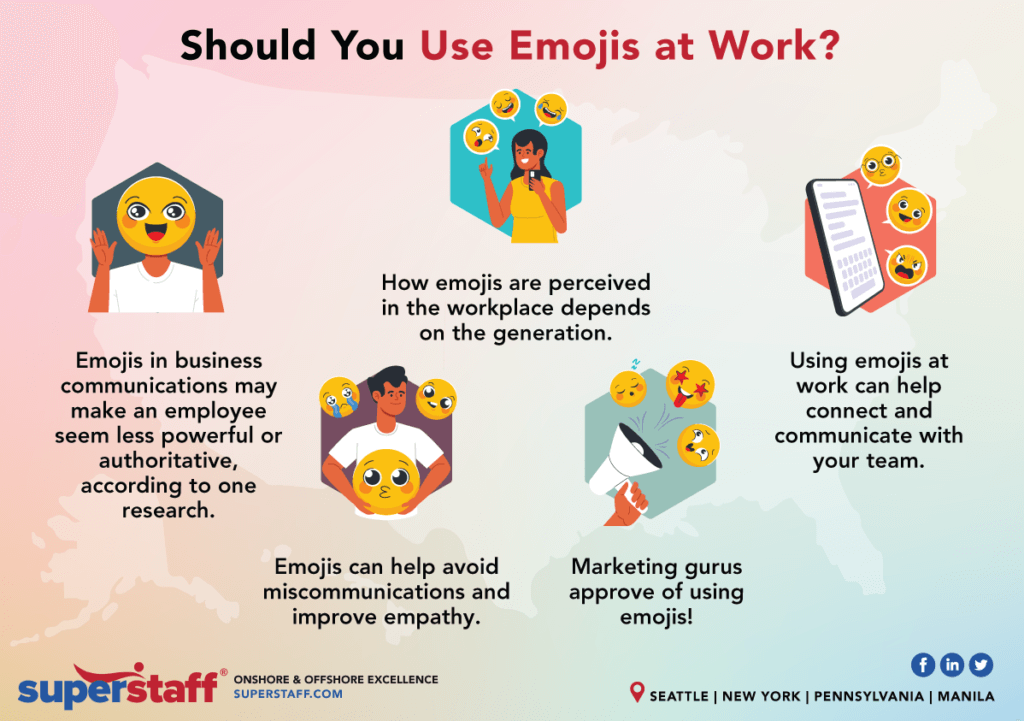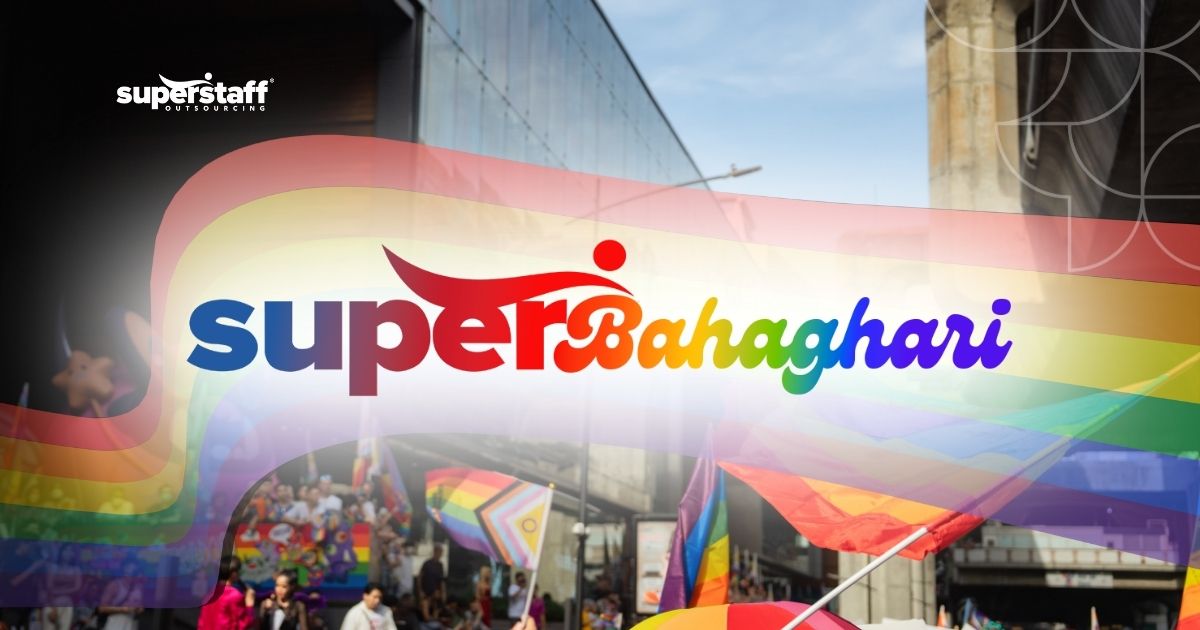
Emojis have become common in everyday text and online conversations, from the ever-popular smiley face to cute and silly pizza icons. Since 1995, these pictograms have added liveliness to our text messages and filled in emotional cues otherwise missing from typed dialogues.
This year, 107 new emojis will be introduced to the general public, driving the total number of emojis to a whopping 3,460! Emojis are so ubiquitous that some people have tried using them in business-related communications like emails, social media marketing posts, Slack messages, and blogs. However, is it appropriate to use emojis at work?
In celebration of World Emoji Day, this article will take a closer look at what the experts say about using emojis in the workplace. Should you send your teammates a “good job smiley” to recognize their hard work, or is it best to keep business and work-related messages emoji-free? Let’s dive in!
Making a Case for Emojis at Work: What Do the Experts Say?
1. Emojis in business communications may make an employee seem less powerful or authoritative, according to one research.
According to a study by Tel Aviv University’s Coller School of Management, using emojis at work may signal less power or authority. In an organizational context, people see purely verbal messages as more authoritative than pictorial messages associated with “low power or influence.” So, if you wish to command power and respect in your work conversations, think twice before sending that smiley face.
On the other hand, the same study found that visual messages convey a desire for social proximity. Employees or business leaders who want to seem approachable and relatable may wish to incorporate the occasional work emoji into their messages.
2. How emojis are perceived in the workplace depends on the generation.
Are you thinking about sharing a “hard work emoji” or “teamwork emoji” in your work group chat? Before you click ‘send,’ it’s essential to understand that your message may be perceived differently depending on the age group of your audience. According to a University of Amsterdam research, what you think about emojis at work will differ depending on your generation.
About 46% of young professionals (aged 18 to 29) say emojis are appropriate for work communications. Some say emojis offer advantages, with 53% saying they see emojis as a better way to express their feelings or make their co-workers smile and laugh. Other young professionals also stated that emojis make the workplace more fun and upbeat.
On the other hand, older professionals (aged 45 and up) give emojis at work a big thumbs down, with only 15% of them saying that emojis improve workplace communication. Most older employees agree that using work emojis makes their colleagues look less professional, less competent, less genuine, and more annoying.
3. Using emojis at work can help connect and communicate with your team.
Although people seem to have mixed reactions to seeing emojis in work messages, some experts argue that these can offer advantages. In fact, using emojis at work can help team leaders gain a deeper insight into their employees’ feelings and emotions.
In the past, business leaders relied on physical cues, such as facial expressions or body language, to gauge how their employees felt. However, with the now-widespread adoption of remote work, face-to-face interactions have decreased, leaving many leaders struggling to connect with their teams. Work emojis have become easy yet fun for leaders to relate and connect with their employees.
Here’s one example: During the start of their virtual meetings, workers at Danske Bank A/S were asked to share the emoji that best represents their mood of the day. The managers found that using emojis, instead of simply asking for standard verbal responses like “I’m fine,” allowed employees to express a broader range of emotions and created richer team interactions.
Read More: Compassion as a Compass: How SuperStaff Navigates the Challenges of Leading in the New Normal

4. Emojis can help avoid miscommunications and improve empathy.
Research studies shared by Forbes found that emojis can help co-workers communicate more effectively in text form. Since emojis can convey a particular tone or message that readers may otherwise misconstrue, colleagues can more easily avoid potential misunderstandings and miscommunications in the workplace.
Some organizations are even using emojis at work in new and innovative ways. One example is the company Cogito which uses AI to analyze human behavior through voice. Then, the software uses emojis to guide call center agents through stressful customer situations. For instance, a coffee cup icon comes up when a customer’s energy seems low, or a heart emoji indicates the need to express empathy and compassion.
5. Marketing gurus approve of using emojis!
We’ve discussed the pros and cons of using emojis at work for internal team communications and messages, but what about the benefits of using emojis for marketing purposes?
Should you include a perfectly placed emoji in your next email or newsletter? Email marketers say yes!
One recent study found that there has been a 775% increase in marketing messages containing emojis. Email marketers increasingly use icons, gifs, and other interactive features to entice readers to engage with their marketing campaigns. A well-placed emoji can help highlight important body text, make headlines stand out, or grab a subscriber’s attention with the first line.
According to Hubspot, using emojis in your subject line can add visual interest to your email, increasing engagement with your recipients. However, it’s best only to use one or two emojis. Adding too many might make your email look spam to your recipient’s email filter.
Read More: Top 8 Must-Know Digital Content Marketing Strategies To Help Fuel Brand Awareness and Growth in 2022
The Verdict
So, what is our final stance on using emojis at work? Are they appropriate and beneficial, or should we steer clear of them in business settings? The answer is: It depends.
Using emojis should be like speaking a language. You wouldn’t speak Mandarin to an Italian person, would you? Similarly, you shouldn’t assume that your emoji-filled text will be immediately understood by the person receiving it. Before you hit ‘send,’ you must know your audience, put yourself in their shoes, and imagine how they will perceive your message.
Remember: Emojis can help convey tones or body language in text form. However, not all signals are universal. For one person, a red-faced emoji might mean anger, while another colleague might interpret it as an embarrassment.
In some countries or cultures, specific hand gestures in emoji form may be considered offensive or rude. So, always keep your target audience’s preferences in mind before using any work emojis.
Want to Use Emojis at Work? Consult the Digital Marketing Professionals First!
Are you stuck deciding whether or not it’s appropriate to add emojis to your latest marketing campaign? Keep calm, and connect with the digital marketing professionals at SuperStaff.
SuperStaff believes that the key to effective digital marketing is creating high-quality, relevant, and engaging content that drives results. Our expert content marketers make sure to produce content tailored to your brand identity and goals and the needs and preferences of your target audience.
We understand the benefits of a well-placed emoji in driving engagement, whether in emails or social media posts. Let our team help you harness the power of language to improve your online presence and brand reputation.
Contact us today, and let’s discuss what our digital marketing solutions can do for you!






